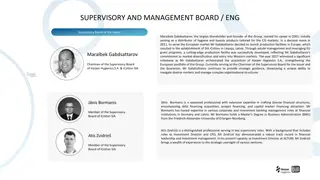
Formal Supervisory Control and Coordination for Many-core Systems
Explore how Formal Supervisory Control Theory (SCT) combines classical control theory and heuristics to meet changing runtime goals, offering a systematic design flow for hierarchical control. This approach addresses robustness, formalism, efficiency, coordination, scalability, autonomy, machine learning, estimation/model-based heuristics, SISO and MIMO control theory, supervised control theory, and major on-chip resource management approaches.
Download Presentation

Please find below an Image/Link to download the presentation.
The content on the website is provided AS IS for your information and personal use only. It may not be sold, licensed, or shared on other websites without obtaining consent from the author. If you encounter any issues during the download, it is possible that the publisher has removed the file from their server.
You are allowed to download the files provided on this website for personal or commercial use, subject to the condition that they are used lawfully. All files are the property of their respective owners.
The content on the website is provided AS IS for your information and personal use only. It may not be sold, licensed, or shared on other websites without obtaining consent from the author.
E N D
Presentation Transcript
SPECTR Formal Supervisory Control and Coordination for Many-core Systems Resource Management Amir M. Rahmani Bryan Donyanavard Tiago M ck Kasra Moazzemi Axel Jantsch Onur Mutlu Nikil Dutt 23rd ACM International Conference on Architectural Support for Programming Languages and Operating Systems Williamsburg, VA, March 2018
Motivation Formal supervisory control theory (SCT) can combine the strengths of classical control theory and heuristics to - meet changing runtime goals (Autonomy) - offer a systematic design flow for hierarchical control (Scalability) Methods Robustness Formalism Efficiency Coordination Scalability Autonomy A Machine learning B Estimation/Model based heuristics C SISO Control Theory D MIMO Control Theory E Supervisory Control Theory [SPECTR] Major on-chip resource management approaches and the key questions they address ( = partially addressed)
Motivation Formal supervisory control theory (SCT) can combine the strengths of classical control theory and heuristics to - meet changing runtime goals (Autonomy) - offer a systematic design flow for hierarchical control (Scalability) Methods Robustness Formalism Efficiency Coordination Scalability Autonomy A Machine learning B Estimation/Model based heuristics C SISO Control Theory D MIMO Control Theory E Supervisory Control Theory [SPECTR] Major on-chip resource management approaches and the key questions they address ( = partially addressed)
Motivation Formal supervisory control theory (SCT) can combine the strengths of classical control theory and heuristics to - meet changing runtime goals (Autonomy) - offer a systematic design flow for hierarchical control (Scalability) Methods Robustness Formalism Efficiency Coordination Scalability Autonomy A Machine learning B Estimation/Model based heuristics C SISO Control Theory D MIMO Control Theory E Supervisory Control Theory [SPECTR] Major on-chip resource management approaches and the key questions they address ( = partially addressed)
SPECTR overview User inputs SPECTR Variable Goals and Policies Con_hi Inf_hi Supervisory Supervisory Controller Controller High-level Plant Model System events Gains1 Gains2 GainsN Controller Refs1 Refs2 RefsN Inf_lo_hi Classic Controller 1 Classic Controller 2 Classic Controller N Leaf s Con_lo2 Con_loN Con_lo1 Physical Inf_lo1 Inf_lo2 Inf_loN Plant Sub-plant 1 Sub-plant 2 Sub-plant N
Case Study ODROID-XU3 platform contains an Exynos 5422 Octa-core SoC System goals: Meet the QoS requirement of the foreground application Ensure the total system power always remains below the Thermal Design Power (TDP) Minimize energy consumption
Case Study ODROID-XU3 platform contains an Exynos 5422 Octa-core SoC System goals: Meet the QoS requirement of the foreground application Ensure the total system power always remains below the Thermal Design Power (TDP) Minimize energy consumption the-art, respectively (in our case study) SPECTR achieves up to 8x and 6x better target QoS and power tracking over state-of-
SPECTR Formal Supervisory Control and Coordination for Many-core Systems Resource Management Amir M. Rahmani Bryan Donyanavard Tiago M ck Kasra Moazzemi Axel Jantsch Onur Mutlu Nikil Dutt 23rd ACM International Conference on Architectural Support for Programming Languages and Operating Systems Williamsburg, VA, March 2018






















